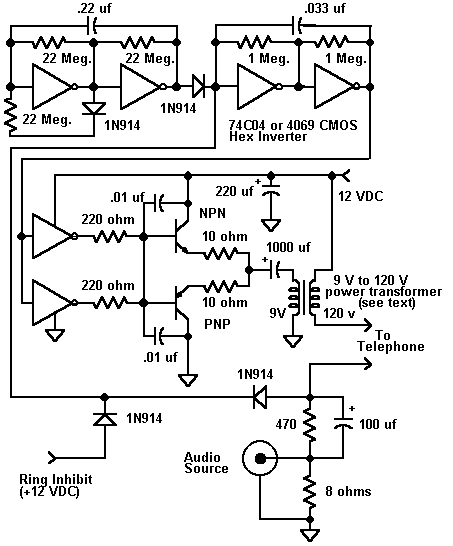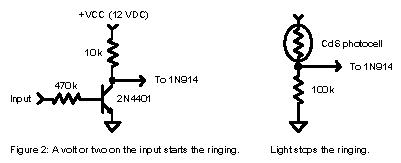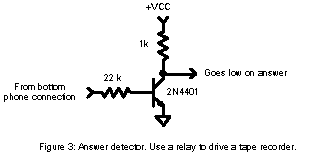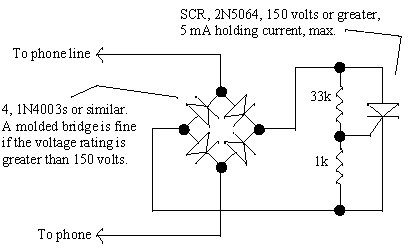

![]()
|
When a new computer modem enters the household, the demands on the home phone line skyrockets. The Internet surfer can use phone time on a par with the most talkative teenager. And the computer modem user can be quite sensitive about his privacy: simply lifting another receiver can knock him off-line causing emotional stress. The phone wiring may be modified so that the modem is always in control by connecting the phone line directly to the modem and connecting the rest of the phones to the modem's "phone" jack. But this solution gives the computer user too much power over the phone line and it doesn't solve the problem if two computers share a single line. Here is a simple blinking LED circuit which will alert users when the line is in use before the receiver is lifted. The circuit loads the phone line so lightly that it meets the on-hook telephone equipment leakage specification and the short lamp flashes draw very little current from the nine-volt battery. One of these devices may be placed at each extension without significantly loading the phone line. The circuit is connected to the red and green wires for a single-line system or the yellow and black wires for the second line in a two-line system. Polarity doesn't matter, thanks to the full-wave rectifier. In order to preserve your phone line balance, do not power this device from a line-powered power supply. Only use a battery as shown and insulate the battery and circuitry by building the device into a plastic case. Do not ground the circuitry. The circuit will work with other batteries and battery voltage. Four AA, C, or even D cells (6 volts) will last considerably longer if you have teenagers burning up your batteries. A small 9-volt rectangular battery will be fine for most users.
Notes:
| The diode bridge eliminates polarity concerns. It may be left out but the wires to the phone line may need to be reversed if the circuit doesn't work properly. | |
| The 22 megohm resistors are sufficiently high to meet phone circuit leakage specifications. | |
| A
2N4401 will usually work in place of the MPSA-18 but if the transistor gain is too low the
flashing will not stop.
|
Caution: The circuit generates a high voltage which can shock.
The Phone Ringer circuit will work with any ordinary phone including older bell ringer types. The circuit rings the phone in a completely realistic manner until someone answers. When the receiver is lifted the user hears the audio of your choice. It might be another telephone, a tape recording, a favorite talk radio show, a fake busy-signal, a scanner tuned to weather or police, cues for the actor who forgot his next line, or whatever audio source strikes your fancy. DC current is passed through the phone to activate the phone’s electronics.
 |
Provisions for experimenters include a ring inhibit control and an additional transistor will activate devices when the phone is answered. The ring inhibit control is used to start the ringing when a signal goes low and the activate-on-answer control can start a tape recording or other device when the phone is answered. For example, the ringer could be triggered by an alarm clock to make an artificial but realistic wake-up call. When you answer, your own voice instructs you about the importance of getting up. This wake-up caller is quite persistent, calling back the instant you hang up!
Do not connect this circuit or the phones used with this circuit to the phone lines.
The phone cable will have red and green wires which are simply connected to the points indicated by the schematic. Polarity should not matter. Other devices may be connected as described but no connection to a "real" phone line is intended.
The circuitry is simple and not particularly critical. The first two inverters form a slow pulse generator which controls the ringing rate. Change the 0.22 uf capacitor to change the ringing rate and change the 22 Meg. resistor in series with the diode to change the length of the ring. The second two inverters generate the 20 Hz ringing signal. This frequency can be changed by changing the .033uf capacitor. Mechanical bell ringers have a resonant clapper and should be driven with a frequency near 20 Hz but a slight variation may give a better ring. The last two inverters buffer the ringing signal and drive the two output transistors. Practically any transistors can be used for the output including 2N4401 and 2N4403 but power transistors in a TO-220 package might be more desirable if a lot of ringing is anticipated. The transistors should be capable of handling several hundred milliamperes. Any low-leakage signal diodes will work for the 1N914s.
The power transformer must handle 20 Hz with at least some efficiency so it is best to use larger units. Molded transformers will work fine but of course they cannot be DC types which have built-in rectifiers. Choose a transformer with a low voltage winding rated for an output voltage well below the DC power supply used. The circuit as shown runs on 12 volts with a 9 volt transformer. Some transformers have 220 volt windings which can give a stronger ring if necessary. A 6 volt filament transformer powered by the circuit as shown will give a quite strong ring. Reduce the 10 ohm emitter resistors to 4.7 ohms to get more ring power if power transistors are used . (Don't leave them out entirely since they help prevent high frequency oscillations.)

Ringing is inhibited by applying a voltage near VCC to the 1N914 diode. A simple transistor inverter can change the sense and increase the sensitivity so that a couple of volts will start the ringing (fig. 2). If the phone is to ring when the squelch of a modern scanner breaks try looking in the scanner for an analog switch integrated circuit. One of its pins will jump between 0 and 5 volts when the squelch breaks and this signal is fine for driving the inverter circuit. Fig. 2 also shows how to connect a photocell so that the phone rings only when the lights are off. (Record a dial tone so the victim concludes that the caller keeps hanging up just as he turns on the light.) The ringer control can also be used in a variety of other ways to automate the ringing. For example, a 470k pull-up resistor combined with a large electrolytic capacitor connected to ground makes an interesting doorbell. Just connect the doorbell switch across the capacitor and the phone will ring for a few seconds when the switch is pushed. (The capacitor discharges quickly but charges slowly.)

Fig. 3 shows how to add an answer activated control. The 1k resistor may be replaced with a relay for controlling a tape recorder. Put a diode across the winding to protect the transistor from inductive kick-back.
The phone ringer may be used to construct a pretend cellular phone system for the kids using an ordinary cordless phone and a regular phone wired in series. Keep the wiring neat and insulated so that the ring voltage doesn't "bite" anyone. Connect the ringer, ordinary phone and the base unit of the cordless phone in series. Wire a switch which enables the ringer and shorts the ordinary phone (two-pole switch). When the cordless phone is answered, flip the switch to talk. Shorting the ordinary phone is probably not necessary but be prepaired for a rather loud buzzing in the earpiece when the other phone rings! The advanced experimenter may wish to build an artificial phone system by adding a on-hook high voltage supply, dial tone oscillators, and appropriate switching circuitry. Quite a challange!
![]()
The Surfer’s Preserver is a simple device that prevents other phones in the house from disrupting your critical Internet session by disconnecting them from the line while you surf! The circuit is also useful in preventing eavesdropping from other extensions since other phones are "dead" until you hang up. The circuit wires in series with either of the offending phone’s wires (red or green) and it is small enough to tuck behind the wall cover plate.
Circuit Description: Due to the resistor divider, the SCR will not fire unless there is at least 17 volts across the bridge. When the receiver is lifted, the full line voltage appears across the circuit and the SCR triggers. The SCR will remain triggered since the DC phone current is about 25 mA and the SCR holding current is only about 5 mA. If the phone line is in use when the receiver is lifted, the line voltage is insufficient to trigger the SCR and the phone remains disconnected. When the phone rings, the 17 volt threshold is quickly passed and the SCR triggers early in the ring voltage cycle, supplying a nearly full amplitude ring voltage to the phone.

A momentary push-button switch may be added across the 33k resistor to manually trigger the SCR so that the phone can connect when another phone is off-hook. This push-button could be mounted in the wall plate if the plate is in a convenient location or the circuit could be built into the telephone itself with a small switch added on the side. This push-button is handy if more than one telephone is on the line.
Other SCRs may be substituted as long as their working voltage is above 150 volts and their holding current is well below your phone’s current. Connect a current meter in series with your phone to determine your current - expect about 25 to 30 mA.
The circuit requires that the modem or other phones pull the line voltage below 17 volts when off-hook. A simple voltage check will determine if the voltage is dropping low enough. It will typically drop to 5 volts. If you must raise the trigger voltage, increase the 33k resistor. A very high resistor value may reduce the ringing volume on older phones or prevent normal phone use.
A separate circuit may be constructed for each phone or one circuit may be used to disconnect several phones. To use one circuit for several phones, make sure that they share a common wire not shared with the modem. Place the circuit in series with the common wire. The advantage of this connection is that the push-button is not needed to transfer a call from one phone to another but some custom wiring may be necessary.
![]()